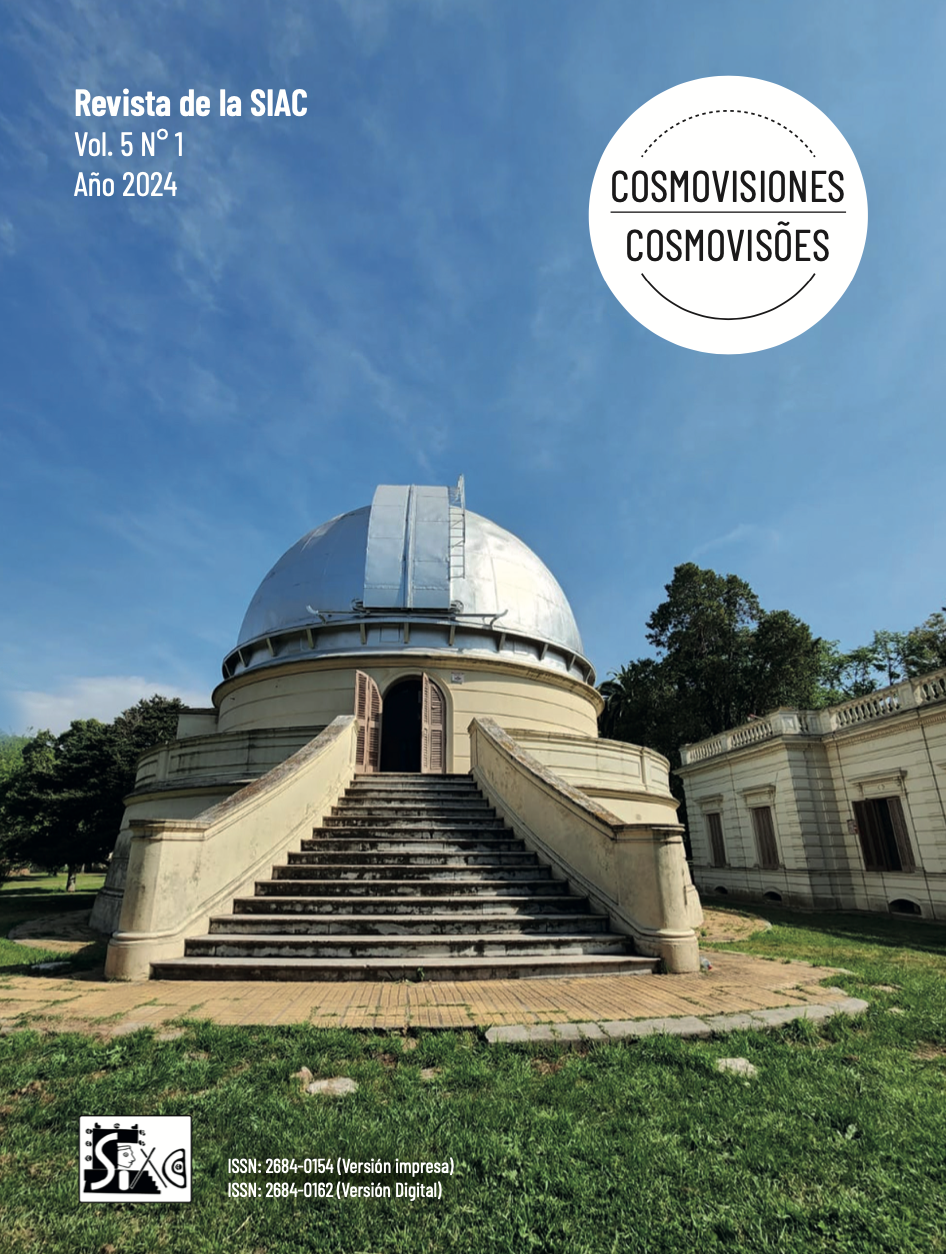When the Scorpion Climbs
Evolutions of Arabic Saj’a Rhymes for Forecasting Seasonal Times
DOI:
https://doi.org/10.24215/26840162e001Keywords:
indigenous Arabian astronomy, heliacal rising, Arabic rhymed prose (sajʿ), seasonal forecasting, folk astronomyAbstract
Traditional naked-eye astronomy was a rich element of Arab culture that figured prominently in the daily lives of herdsmen, farmers and fishermen, and others (Varisco 2000). These cultural practices were passed down from ancestors to successors, and the knowledge was preserved through oral poetry and rhymed prose, both of them ancient and honored Arab traditions. Abbasid (750-1258 CE) historians were the first to document traditional Arab astronomical knowledge, the most complete extant work being the Kitab al-Anwā’ (1956) of Ibn Qutayba (d. 889 CE). His work and the remnants of other works (see Ibn Sīda 1898-1903; al-Marzūqī 1914; Quṭrub 1985; and al-Ṣūfī 1981) reveal the breadth of application of local star knowledge to the prediction of seasonal weather changes that in turn forecast various elements of floral, faunal and social cycles (Henninger 1954; Pellat 1955; Varisco 1991).
Observed in the waxing twilight of dawn, the cosmical settings of stars were culturally significant and featured strongly in poetry and the Qur’ān, but heliacal risings were prevalent within the medium of rhymed prose (sajʿ). Possibly a precursor to the first forms of classical Arabic poetry, sajʿ featured a rhyme at the end of each phrase without any internal meter or required number of syllables. Within the context of heliacal risings, sajʿ was formulaic, beginning with the phrase, “When [star] rises, …” The rhymed phrases that followed this opening connected the seasonal time of the heliacal rising of the star or asterism with characteristics of the floral, faunal and social activities that were undertaken during that time. This structure made pieces of sajʿ easy to transmit and remember, preserving the intimate knowledge of life in the desert among the Arabs, who observed “the blowing of the winds, the rising of the stars, and the changing of the seasons” (al-Marzūqī 1914, 2:179-180). Attributions of authorship were never identified within the literature that remains extant, indicating that the these rhymed prose sayings developed organically out of Arabian society.
In this paper, the author examines the development of rhymed prose over time for the celestial complex of the Scorpion (al-ʿaqrab) as an example of the ongoing social process of construction of these pieces of rhymed prose and their evolving utility for seasonal forecasting. Over time, there developed pieces of sajʿ for the Scorpion as a whole and for each of its four constituent parts: the Pincer (az-zubānā), the Crown (al-iklīl), the Heart (al-qalb), and the Raised Tail (ash-shawla). The sajʿ for the Scorpion provides insight into the processes of change in social astronomical systems that continue to evolve over time rather than remaining static. As such, these living skies of Arabia are windows into the integral roles that indigenous astronomies play within a society.
Downloads
References
Henninger, Joseph. 1954. “Über Stern- kunde und Sternkult in Nord und Zen- tral-arabien.” Zeitschrift fur Ethnologie 79: 82-117.
Ibn Qutayba al-Dīnawarī, Abū Muḥam- mad ʿAbdallah b. Muslim. 1956. Kitāb al-Anwāʾ (fī mawāsim al-ʿArab). Hyder- abad: Maṭbaʿat Majlis Dāʾirat al-Maʿārif al-ʿUthmāniyya.
Ibn Sīda, Abu al-Ḥasan ʿAlī b. Ismāʿīl. 1898-1903. Kitāb al-Mukhaṣṣaṣ. 16 vols. Būlāk, Egypt: al-Maṭba ʿa al-Kubrā al-Amīri- yya.
al-Marzūqī, Abū ʿAlī Aḥmad b. Muḥam- mad b. al-Ḥasan. 1914. Kitāb al-Azmina waʿl-Amkina. 2 vols. Hyderabad: Maṭbaʿat Majlis Dāʾirat al-Maʿārif al-Kāʾina.
Pellat, Charles. 1955. “Dictons Rimés, Anwāʾ et Mansions Lunaires Chez Les Ara- bes.” Arabica 2(1): 17-41.
Quṭrub, Abū ʿAlī Muḥammad b. al-Mus- tanīr. 1985. Kitāb al-Azmina wa Talbiyat al-Jāhiliyya. Ed. Ḥatim Ṣāmiḥ al-Ḍāmin. Bei- rut: Muʾassisat al-Risāla.
Rogers, John H. “Origins of the ancient constellations: I. The Mesopotamian tradi- tions.” Journal of the British Astronomical Association 108:1 (1998).
al-Ṣūfī, Abū al-Ḥusayn ʿAbd al-Raḥmān b. ʿUmar. 1981. Kitāb Ṣuwar al-Kawākib al-Thamāniya wa'l-Arbaʿīn. Beirut: Dār al- Āfāq al-Jadīda.
Varisco, Daniel M. 1991. “The Origin of the Anwāʾ in Arab Tradition.” Studia Islam- ica (74):5.
Varisco, Daniel M. 2000. “Islamic Folk Astronomy.” In Astronomy across Cultures: The History of Non-Western Astronomy. Ed. Helaine Selin. Dordrecht, The Netherlands: Kluwer Academic.
Downloads
Published
How to Cite
Issue
Section
License
Copyright (c) 2024 Danielle K. Adams

This work is licensed under a Creative Commons Attribution-NonCommercial-ShareAlike 4.0 International License.
Authors who publish in this journal agree to the following terms:
The authors retain intellectual authorship of the work and guarantee the journal the right to be the first publication of the work.
Authors may share the work with acknowledgment of authorship and the initial publication in this journal.
Authors may separately establish additional agreements for the non-exclusive distribution of the version of the work published in the journal (for example, placing it in an institutional repository or publishing it in a book), with an acknowledgment of its initial publication in this journal.
The journal offers free access ("open access") to all its content. The articles are available to be read, downloaded, copied, printed and/or researched according to the Creative Commons license: CC BY-NC-SA (Attribution - Non-Commercial - Share Alike-4.0 International)

The content of the journal is fully available from its publication. Readers are required to correctly cite the journal and the author of the downloaded content
















